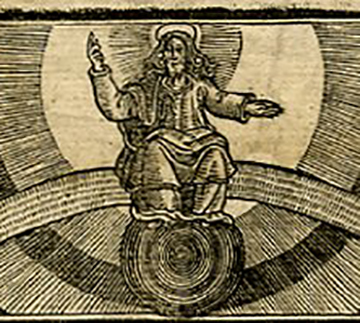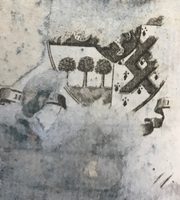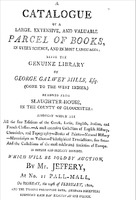Honor, Virtutis, Pretium
A useful strategy in tracing the provenance of a book is identifying any marks its owner left behind. On top of the marginalia that has been discussed, one of the biggest clues pertaining to where Acts and Monuments has been is a damaged bookplate in the front cover of volume one. A bookplate is an ownership label printed from an engraved or etched block, typically cut into metal or wood (Pearson 54). The practice is first noticed in Germany in the latter half of the fifteenth century, and bookplates eventually became common in Britain nearly a century later. Although missing the top half and a large section of its bottom, the bookplate in UVic’s Acts and Monuments indicates a common element among bookplates: heraldry. Heraldry involves a unique coat of arms assigned for specific families that were inherited from father to son, and the use of family crests as bookplates help identify books that once belonged to private family libraries. Despite being damaged, the bookplate has retained enough features to be identifiable, especially since designs in the top half were often repeated in the bottom sections. The sections in heraldry are called quarters. Specifically, the two remaining quarters indicate the wife’s crest and the owner’s family crest, respectively. Often the man's family design was repeated in the first and fourth quarters, while the wife's family was repeated in the second and third. As well, the wife's lineage was depicted in the smaller, decorative shield in the middle, which is called an escutcheon. These key points make identification possible, and through the generous help of the Bookplate Society in Britain, we now know that the damaged bookplate belonged to one George Galwey Mills, Esqr.
George Galwey Mills was born October 22 1765 on his father’s plantation on St. Kitts, a small island in the Caribbean. He was educated in England, and was admitted to the bar in 1786 (thus his Esqr. status), though it seems he never practiced law. Instead, a year after marrying Amelia Norton, Mills inherited his father’s plantations and began pursuing a career in politics. Living in a large country house near the villages of Upper and Lower Slaughter in Gloucestershire, Mills attempted to live an extravagant life as a country gentleman and keep up associations with some of the most famous individuals in eighteenth century Britain. For example, Warren Hastings, former Governor-General of India, and the naval hero Rear Admiral Lord Nelson, are both listed as godfathers to Mills’ son. That Mills attempted to live in extravagance is suggested by the impressive library he had collected. Financial problems, however, soon beset Mills, and he ended up selling his library through an auction house February 24 1800, shortly before departing for the West Indies in an attempt to avoid his creditors. This specific auction house specialized in quick auction sales, which "no doubt suited George Galwey Mills's situation very well" (Backhouse 60).
Looking to Books for Prestige
The sale catalogue reveals the caliber of books Mills had collected, most notably The Sherborne Missal, which is a medieval illuminated manuscript describing the ordinances of the Catholic Church. Mills purchased the Missal in 1797 and is the first recorded English owner of the manuscript after the Reformation. Owning such an item is a clear demonstration of status. Interestingly enough, Acts and Monuments is also listed for sale, but the record states it is the 1684 edition, not the 1610 currently at UVic. There are two possibilities for this: the catalogue simply made a mistake in the date, or Mills kept/bought the 1610 edition after the sale. Given that Acts and Monuments is listed as three volumes, however, the publication year is probably correct. Despite the uncertainty in when or how Mills acquired the 1610 edition, it seems likely that the two volumes ended up in the Marquis of Hastings library shortly after leaving the possession of Mills. As well, it is our best guess that the two volumes received new bindings while under Mills’ care, as a final note in the library sales catalogue observes that the books of his library had excellent bindings. Despite not knowing how to manage his finances, at least it can be said he knew how to take care of books.

The Other Fox: the 1684 edition sold by Mills
The listing of the catalogue creates questions as to when Mills' owned the 1610 edition
End of the Line
Financial problems continued to plague Mills on his return to England in 1804. He was arrested and detained on the king’s bench in 1806 due to debts totaling £43 000—a sum totaling $5 936 902.50 (CAD) today. Mills’ creditors ranged from bankers to his laundry man, suggesting his attempt to live lavishly had finally caught up with him. Following his eventual release, Mills pursued a career in politics, holding a seat in Parliament from 1807-1808 and 1818-1820. In between his stint in Parliament, he went abroad to the continent as a diplomatic ambassador, although his personal correspondences suggest he was, in fact, a spy for hire.
After his wife’s death, he accepted a post in 1823 as the registrar of the supreme court in New South Wales (Australia) where, having “received distressing news from home and [being] deeply in debt, being ‘a man of profligate character and dissolute habits’”, he shot himself in the head with a pistol on February 14 1828 (Coroner's Report). Witnesses cited in the coroner’s report say Mills had been seen walking down the street the day before, talking loudly to himself while gnawing at the end of his umbrella. A bottle of laudanum, a sort of concoction with opium, was found in his study where he shot himself, and several prescriptions for the substance suggest he had been struggling with depression for several months.
Turbulent life story aside, solving the riddle of the damaged bookplate shows an important shift in the motivations behind owning a copy of Acts and Monuments. Instead of a religious obligation, George Galwey Mills collected the anti-Catholic Acts and Monuments right alongside one of the most famous Catholic manuscripts from the Middle Ages; despite the differences in dogmas, both had social significance. Mills assembled his library out of pursuit for prestige, not piety. Given the rich historical association with John Foxe, owning an edition of Acts and Monuments was a tangible way of owning a piece of British history that gave its owner status, a status to which Mills desperately tried to live up to. His failure to do so is likely the reason his bookplate was eventually ripped out by a future owner in order to remove any association with him.
Works Cited
- Backhouse, Janet. The Sherborne Missal. University of Toronto Press, Toronto, 1999.
- Coroner's Inquest, The Sydney Gazette and New South Wales Advertiser, Fri 15 Feb 1828, National Library of Australia. Access here:
- Dibdin, Thomas Frognall. Biblomania; or Book-Madness; A Bibliographical Romance. University of Adelaide, 1809. Access here:
- George Galwey Mills Esqr. The History of Parliament: British Political, Social & Local History. Access here:
-
Pearson, David. Provenance Research in Book History: A Handbook. The British Library, 1994.
-
Ripley, Wayne C. "New "Night Thoughts" Sightings." Blake, vol. 47, no. 2, 2013, np. Access here:





